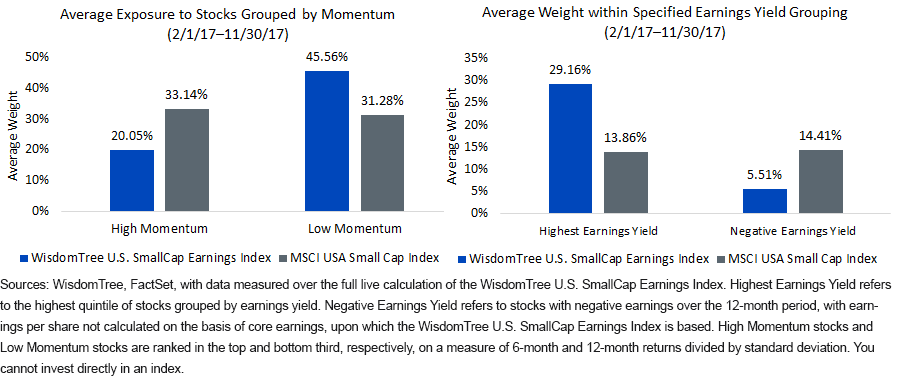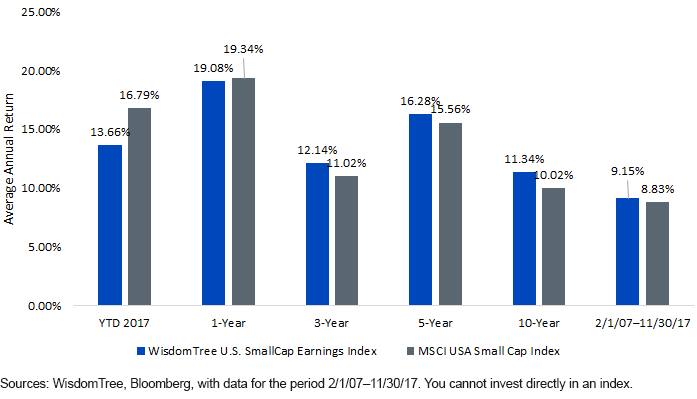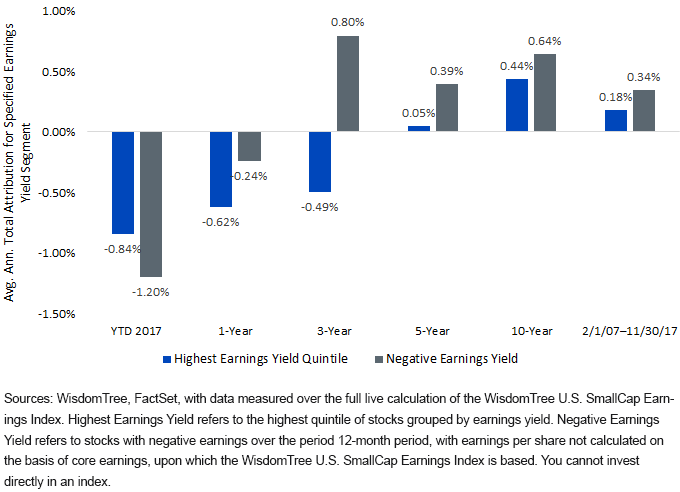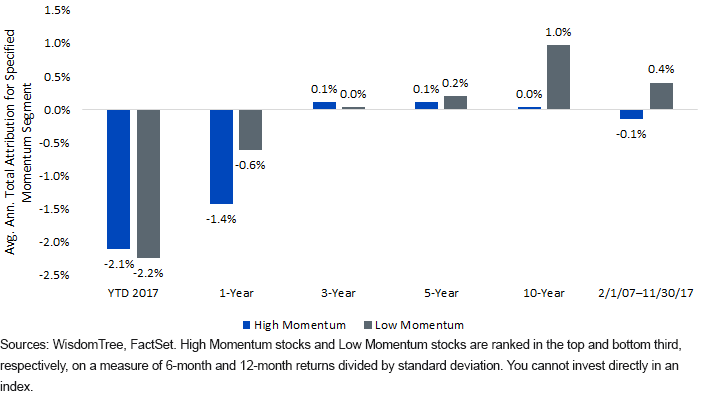Do WisdomTree U.S. Earnings Indexes “Work”?



We’ve been writing a lot lately about the connection between factor risk premiums and any potential to achieve modern alpha. One of the best things about WisdomTree is a long track record from which to evaluate any measure of success in this area.
A Value Tilt with an “Anti-Momentum” Bias
Over time, it has become clear that WisdomTree’s equity approaches offer greater contrasts to market capitalization-weighted benchmarks in less efficient areas of the market. With that in mind, we focus on comparing the WisdomTree U.S. SmallCap Earnings Index with the MSCI USA Small Cap Index. Our annual rebalance—which happens the last trading day of November each year—has tended to do two things very consistently:
1. Raise Earnings Yields (Lower Price-to-Earnings [P/E] Ratios): When adjusting exposure to give firms with the greatest earnings the largest weights, as well as eliminating exposure to firms with negative earnings, the natural consequence is lowering valuations based on measures of earnings.
2. Break the Link between a Rising Share Price and Increasing Weight (Anti-Momentum): Market Capitalization = Price per Share x Number of Shares Outstanding. It’s clear, therefore, how a rising price leads to a rising market capitalization—in other words, greater weight within a market capitalization-weighted index. A way to see this—take Facebook, Amazon, Netflix and Google (the FANG stocks), which had a combined weight of 5.61% in the S&P 500 Index as of December 31, 2016. Year-to-date (YTD) through December 7, 2017, these stocks had delivered a weighted average performance of about 46% (compared with the full S&P 500 Index at 20.72%), and their combined weight had grown to 7.05%.1
A market capitalization-weighted approach will add weight to stocks that are outperforming and therefore increasing their market capitalization relative to the rest of the index, and this is one of the biggest contrasts that exists between market capitalization weighting and fundamentally focused rebalancing.
A Track Record of Raising Earnings Yields and Anti-Momentum Exposure

An Impressive Long-Term Track Record with Near-Term Underperformance

The total returns of a given equity index tend to be the first thing that investors can easily see and study. When comparing the WisdomTree U.S. SmallCap Earnings Index against the MSCI USA Small Cap Index benchmark, we see the following:
- On the three-year horizons and longer, as of November 30, 2017, the WisdomTree Index outperformed the MSCI index.
- On the one-year and YTD horizons, the MSCI index outperformed the WisdomTree Index.
We set out to use unique attribution studies, based on grouping stocks by earnings yield and momentum, with the goal of explaining both the outperformance and underperformance of the WisdomTree U.S. SmallCap Earnings Index.
Earnings Yield-Based Attribution

- It would be nice if the lowest P/E or highest earnings yield stocks always outperformed, but the fact is they do not. We can see from the chart that the combined impact of stock selection and allocation toward the highest earnings yield quintile helped relative performance of the WisdomTree strategy over the since inception, 10-year and 5-year periods, but not during the YTD, 1-year, and 3-year periods.
- The other critical point is how the WisdomTree methodology tilts away from more speculative stocks that have generated negative earnings—but it’s true that sometimes these stocks outperform. Over the YTD and 1-year periods—periods where we know that the WisdomTree U.S. SmallCap Earnings Index underperformed the MSCI USA Small Cap Index—we can see that the combined allocation toward and selection within this grouping led to negative relative performance.
Momentum-Based Attribution

- The combined impact of stock selection within and weighting of the lowest-momentum stocks delivered its greatest relative benefit over the 10-year period. Positioning related to this grouping detracted over the YTD and 1-year periods.
- Over the 1-year period, as well as in the 2017 YTD period, where we know that stocks with strong momentum have done well, we see that the combined effects of selection within and weighting of the High and Low Momentum groupings hurt the WisdomTree strategy relative to the MSCI strategy.
How This Knowledge Can Help with Manager Selection and Portfolio Construction
While some people may have an initial reaction of “so what?” we think that this represents a very important foundational understanding of how the WisdomTree U.S. SmallCap Earnings Index works. It can also tell us that if one were to have a complementary exposure to a high-momentum, small-cap approach, the two strategies working in tandem may lead to a lower risk of underperformance and being out of favor. Analysis like this can really be used to thinking in a broader context about how different strategies that are attempting to generate modern alpha may complement one another.
1Source: Bloomberg.

Christopher Gannatti began at WisdomTree as a Research Analyst in December 2010, working directly with Jeremy Schwartz, CFA®, Director of Research. In January of 2014, he was promoted to Associate Director of Research where he was responsible to lead different groups of analysts and strategists within the broader Research team at WisdomTree. In February of 2018, Christopher was promoted to Head of Research, Europe, where he was based out of WisdomTree’s London office and was responsible for the full WisdomTree research effort within the European market, as well as supporting the UCITs platform globally. In November 2021, Christopher was promoted to Global Head of Research, now responsible for numerous communications on investment strategy globally, particularly in the thematic equity space. Christopher came to WisdomTree from Lord Abbett, where he worked for four and a half years as a Regional Consultant. He received his MBA in Quantitative Finance, Accounting, and Economics from NYU’s Stern School of Business in 2010, and he received his bachelor’s degree from Colgate University in Economics in 2006. Christopher is a holder of the Chartered Financial Analyst Designation.

Alejandro Saltiel joined WisdomTree in May 2017 as part of the Quantitative Research team. Alejandro oversees the firm’s Equity indexes and actively managed ETFs. He is also involved in the design and analysis of new and existing strategies. Alejandro leads the quantitative analysis efforts across equities and alternatives and contributes to the firm’s website tools and model portfolio infrastructure. Prior to joining WisdomTree, Alejandro worked at HSBC Asset Management’s Mexico City office as Portfolio Manager for multi-asset mutual funds. Alejandro received his Master’s in Financial Engineering degree from Columbia University in 2017 and a Bachelor’s in Engineering degree from the Instituto Tecnológico Autónomo de México (ITAM) in 2010. He is a holder of the Chartered Financial Analyst designation.

